Last of two parts
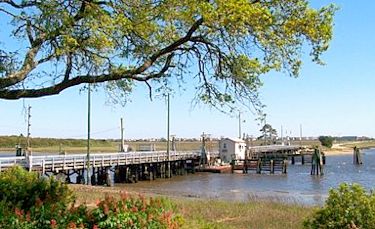 |
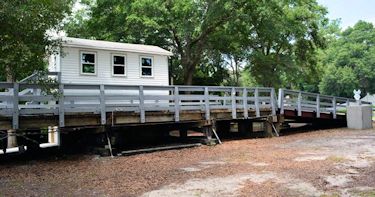 The old pontoon bridge once served as a vital link between Sunset Beach and the mainland. It has been moved and preserved as an important connection to Sunset’s past. Photos: Old Bridge Preservation Society |
SUNSET BEACH – The old pontoon swing bridge that opened on the hour every hour since 1958 is the symbol of Sunset Beach. Though replaced a few years ago by a high-rise, concrete monstrosity, the quaint little bridge has been preserved and still occupies a special place in the history of a young town and in the hearts of its inhabitants.
Supporter Spotlight
Its image can still be found on t-shirts, coffee mugs, baseball caps, flags and license plates. And though it no longer serves as a vital transportation link, the old bridge is still an important connection to the past.
“The Town of Sunset Beach is the mainland and the island, which distinguishes us and gives us an identity. That bridge is a connection in more than just the literal sense,” said Ann Bokelman, one of the founders of the Old Bridge Preservation Society.
She will talk about the bridge and its importance in the history of Sunset Beach on Dec. 10 at the Museum of Coastal Carolina in nearby Ocean Isle Beach.
For nearly three decades, Sunset Beach residents debated whether or not to replace the old bridge with a new high-rise bridge. Proponents worried about the safety of the old bridge or grew tired of the long waits to get across and the frequent break downs. Others feared that a high-rise bridge would encourage faster development and jeopardize the island’s isolation and tranquility.
When they learned that the N.C. Department of Transportation would demolish the iconic swing bridge and replace it with $31 million high-rise bridge, Bokelman and two other Sunset Beach women fought unsuccessfully to persuade the town to save it. In 2010, with the new bridge nearly completed, the women formed the Old Bridge Preservation Society and bought the bridge for $1.
Supporter Spotlight
Sunset Beach was only incorporated in 1963, making it a very young town that is celebrating its 50th anniversary this year. There are no 200 year-old buildings or famous historic battlegrounds. The old pontoon bridge, then, serves an important piece of history.
 Mannon Gore |
In 1955 Mannon Gore, a farmer, bought the island Bald Beach and renamed it Sunset Beach because he loved watching the sunsets from there.
“Dad had a great talent and a great vision,” said his son Ed Gore.
Although he never had any formal education, Gore had a genius for looking at something and understanding how it worked. “He would find a way, the poor man’s way,” noted his son.
Gore first built a small dredge that he called the Little Dawn, which he modeled after the much larger dredge that he served on while in the Coast Guard. He used Little Dawn to build two causeways, one on the island and the other on the mainland. Then he engineered World War II surplus barges so that they swung like a door, opening and closing the Intracoastal Waterway and connecting the two causeways.
“It was an antique thing that was doing the job that a multi-million dollar bridge would’ve done,” said Ed Gore.
Once the bridge was built in 1958 the island became accessible. Gore began selling lots. “Dad made sure that there would be no large commercial district on the beach,” said Ed Gore.
To this day Sunset Beach remains an unspoiled beach and a residential family town, just as Gore had originally envisioned.
Gore lived by the waterway close to the bridge, which he left in the open position so that it didn’t obstruct the waterway. When a motorist wanted to cross the bridge he would honk his horn or at night flash his headlights. “Mr. Gore would come out and operate the bridge, sometimes in his bathrobe flapping in the breeze and probably sometimes in the middle of dinner too, I am told,” said Bokelman.
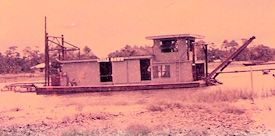 Mannon Gore built the Little Dawn so that he could build a bridge to the island he bought and called Sunset Beach. Photo courtesy of Ed Gore |
In the early 1960s, the state built a replacement bridge using Gore’s basic design except that it was a pontoon that floated. The one-lane bridge that spanned 110 feet had a wooden center section and two metal ramps on either side that would connect to the causeways and accommodate for the level of the rising and falling tides.
“One of those things that people really liked about going over the bridge is that you were close to the water, you were close to the marsh, you could see everything. Going across the bridge the tires would make this ka-thump, ka-thump, ka-thump sound,” said Bokelman.
The sound earned the old bridge its reputation as the heartbeat of Sunset Beach.
A small, white tender’s house stood in the middle of the pontoon bridge. It contained a large diesel engine that powered three winches: one to pull the bridge open, one to pull it closed and one to operate the counterweights. The last thing the bridge tender did was sink the cables. Then, he would sound a siren.
“He sounded one when he was getting ready to open and let the boats go through; and then he sounded one when he was closing, and it meant if you weren’t in line to go through you were out of luck,” said Bokelman.
If only a few boats passed, the whole operation would take about 15 minutes; if a large barge passed, 30 minutes. However, it wasn’t unusual for the bridge to break down and take several hours to reopen. Sometimes boaters would shoot through before the bridge tender dropped the cables and catch their props on them.
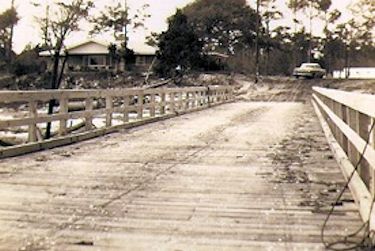 |
 Mannon Gore built the first wooden bridge to Sunset Beach on World War II barges that swung open and closed. Photos courtesy of Ed Gore |
The bridge created inconveniences for boat and car traffic and, of course,for emergency vehicles. “It was a safety issue and I understood why the town and the state wanted to build a new bridge,” said Karen Joseph, a Sunset Beach councilwoman and a member of the Old Bridge Preservation Society.
For two years, residents watched as the construction of a 65-foot tall bridge slowly dwarfed the old one. Word spread that the old bridge would soon be demolished. Karen Dombowski, Chris Wilson and Bokelman started lobbying for the town to save the bridge.
“In the beginning we really were just trying to, rather naively, make sure that the town would save the bridge,” said Bokelman. “It seemed to us that something so integral to the history and the development of Sunset Beach, of course everyone would want to save it.”
They launched a campaign and collected over 6,000 signatures, a considerable feat for a town with only 3,600 fulltime residents. Initially the town voted to save the old bridge, but the decision was later overturned with only a couple months to spare before the old bridge would be removed and scraped.
The women formed the Old Bridge Preservation Society, a non-profit organization, and convinced the bridge’s owner—the construction company hired to build the new bridge—to give it to them. With only a month to go and nowhere to put the old bridge, Ronnie and Clarice Holden, who own Twin Lakes Seafood Restaurant and Island Breeze boutique, offered to move it onto their land.
“I was very pleased there was a private movement to save it,” said Joseph. “I believe that it is very important for us, not only us as a town but as a state and indeed as a nation to restore and preserve history.”
For the last year the preservation society has been busy restoring the old swing bridge and tender house with the financial support of the community. One small contribution at a time, the tender house was re-wired, and a new foundation was put in along with windows and a garage door where the opening for the machinery existed. The old bridge was anchored down permanently, and railings and ramps were built for public access. The local Sherwin Williams paint store and two local paint contractors donated their materials and labor to repaint both structures.
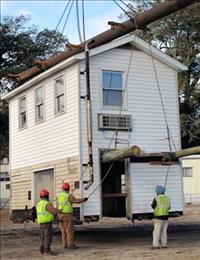 The old tender’s house is removed from the pontoon bridge. Photo: Old Bridge Preservation Society |
The restored tender house will serve as the island’s first history museum. Visitors will see the original outfitting of the tender office along with memorabilia, photographs, tools and public records. There will be video footage of the old pontoon swing bridge in action and stories told by the bridge tenders both live and recorded. The museum is scheduled to open in May 2014 and will include an exhibit of The Vesta, the Civil War blockade-runner that ran a ground at Bald Beach in 1864.
“It’s certainly understandable why we needed a new bridge, but we’re happy that we were able to keep, not only the heartbeat, but the heart of Sunset Beach,” said Bokelman.
Her presentation next week, Tales from the Old Bridge – A Peek into History, will be free for museum and dual museum-planetarium members. Non-member admission: $8 adults, $7 seniors, $6 children and free for ages 2 and under. She’ll start at 6 p.m.







